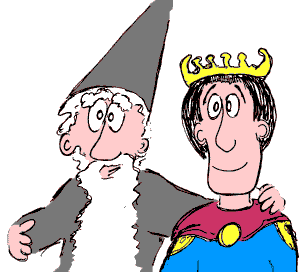|

|
Arthurian
Legends
Activity ideas
Click here to see 'Tales from Camelot' (the book that is mentioned below)
|
Our 'Tales from Camelot'
book was created over several weeks using both Literacy time and
additional English lessons.
We chose to study the
Arthurian Legends to cover the relevant text level work in the
Literacy strategy. Many of these text level teaching objectives
were ongoing throughout the whole unit.
We started, in a normal
English lesson, by looking at the story of how Arthur came to
power. The class listened to and discussed the story of Arthur,
Merlin and the sword in the stone. We explored what we already
knew about the Arthurian Legends. Many of the children knew snippets
about Excalibur, the Lady of the Lake etc.
The follow-up activity
was based on my cartoon version of King Arthur.
Presented with just the cartoon pictures the children wrote their
own story captions to go underneath. The less-able children sequenced
my original captions and pictures.
In Literacy we focused
on the plots of Arthurian legends. The class was presented with
outlines of various tales and we worked together to identify the
common elements and themes.
We then worked as a
whole class to come up with four plots of our own. We came up
with a name for our knights, decided what they where going on
a quest for and came up with three main events in the story. (Problem/solution).
In a Literacy Hour
on adjectives the children were presented with pictures of the
various 'knights'. The pictures were taken from the excellent
'A Tolkien Bestiary' by David Day. The children built up banks
of adjectives to describe the knights they were presented with
and then went on to write a paragraph about the character. Each
group had a different knight to write about and in my more-able
group they had a different knight for each group. The descriptions
were created over two Literacy sessions and before each section
of individual work we worked together to produce adjectives for
a class character (on the first day) and extend them into a full
description (on day two). I combined each child's description
of the knight into a single group description. These descriptions
then formed the 'Brave Knights of Camelot' introductory section
of the class book.
Continuing the work
on adjectives we used another of the pictures from David Day's
book over two days in the whole class period of the Hour. The
children were told that the picture was of Camelot. We used it
as stimulus again to produce adjectives that described Camelot
and we put these adjectives into sentences. During the next day
we put the sentences in an order we liked (this was a very worthwhile
aspect of the whole process and led to lots of interesting discussions),
added any extra sections that were needed and then we extended
the opening description to take the reader up towards and into
Camelot and start the story.
We did further work
in our English lessons looking at some other Arthurian tales.
Work on King Arthur, Sir Pellinore and Excalibur was followed-up
by getting the children to retell the events that they had listened
to from the point of view of Arthur. Individual accounts were
combined to produce the first 'tale' in our class book.
The main stories in
the book were written mainly during Literacy Hour over several
weeks as detailed below. Each Literacy group were given one of
the plots that we had come up with to turn into a story (additional
plots came from our parallel class).
In their guided group
sessions the children worked with me to create their story chapter.
We used one of our Becta portables to write the story together.
All the children sat round the laptop, told me what to type and
offered suggestions of how things could be changed. Using the
computer like this was a huge bonus as we could go back and alter
things that didn't sound write, go back and change plot elements
etc. I was able to work a lot of word and sentence work into these
sessions.
The day after their
guided group session the children were given a printout of the
previous days work which they had to redraft and extend ready
for the next session guided group session where we compared what
mistakes we'd found and debated any changes to be made in the
text.
In addition to the
activities listed above we had other lessons focusing on Arthurian
legends.
The children rewrote
the 'Sword in the stone' story from the point of view of Morgan
le Fey. This didn't make it into the final book. Our printed version
of the class book also features the children's letters from King
Arthur to their particular knight about their quest with Arthur
making comments about things that happened in their quest, rewarding/punishing
them, thanking them etc. [The letters may well be added to the
on-line version of the book at a later date]
One of the other fun
activities we did was 'The Camelot Games'. The children went away
into groups and wrote their own radio commentary on an Olympic-style
Camelot games. They came up with some great events such as jousting,
sword fighting, wrestling, racing etc. Each little 'report' featured
commentary and interviews with the knights afterwards. They really
enjoyed both the writing side and the performance. We recorded
the performances and I was really impressed by the way certain
children, who I didn't think would dare to perform in front of
the rest of the class, really got into their roles.
|

